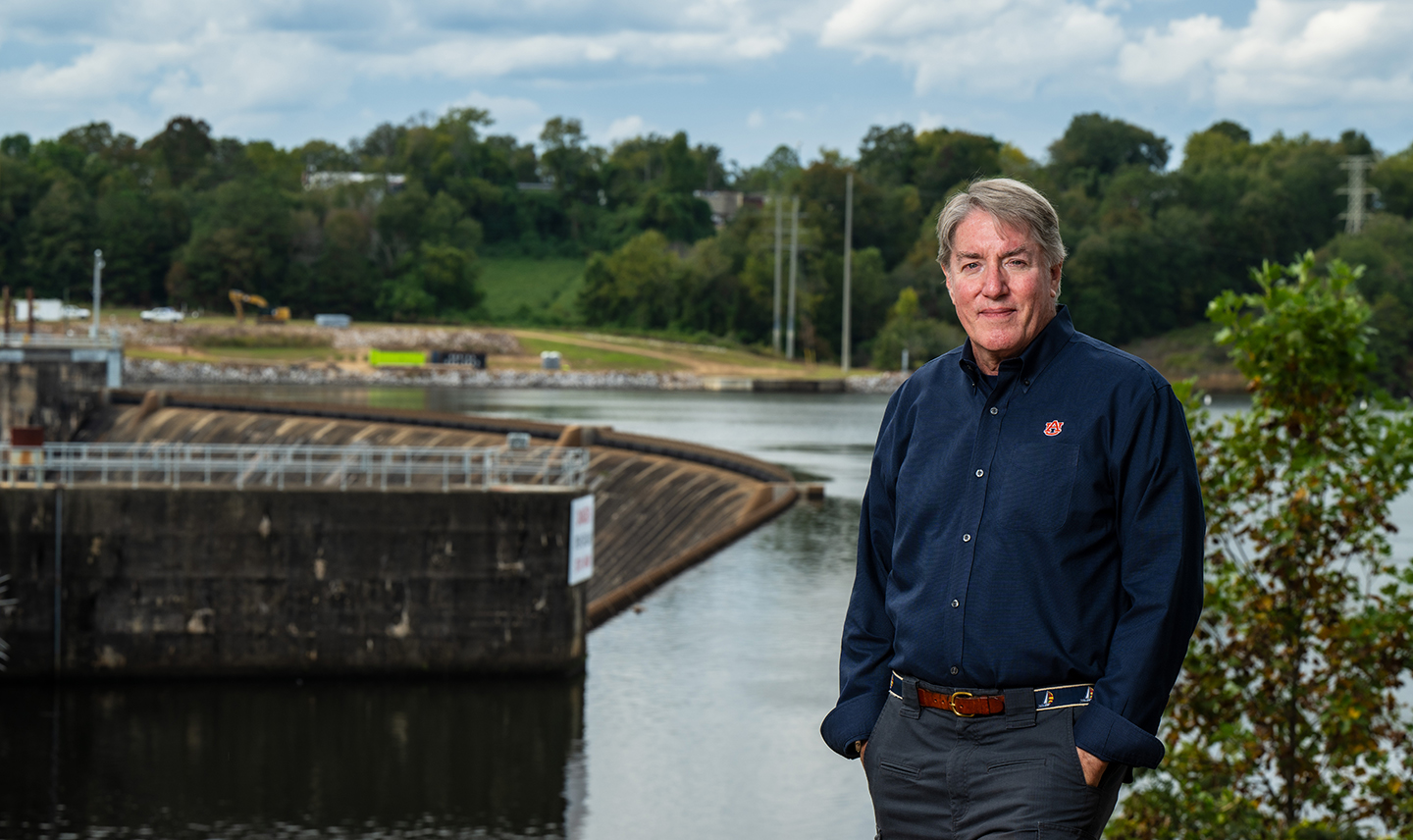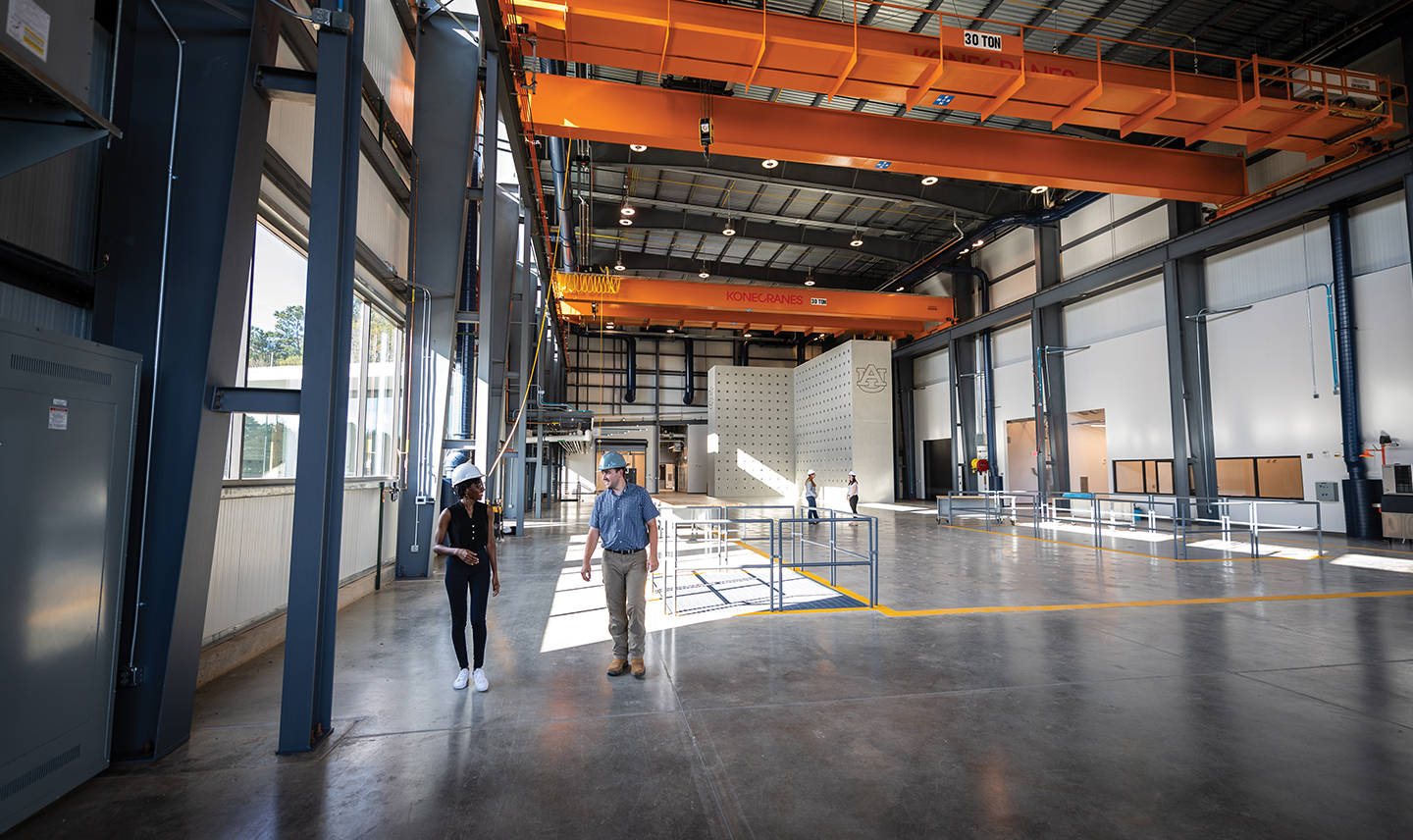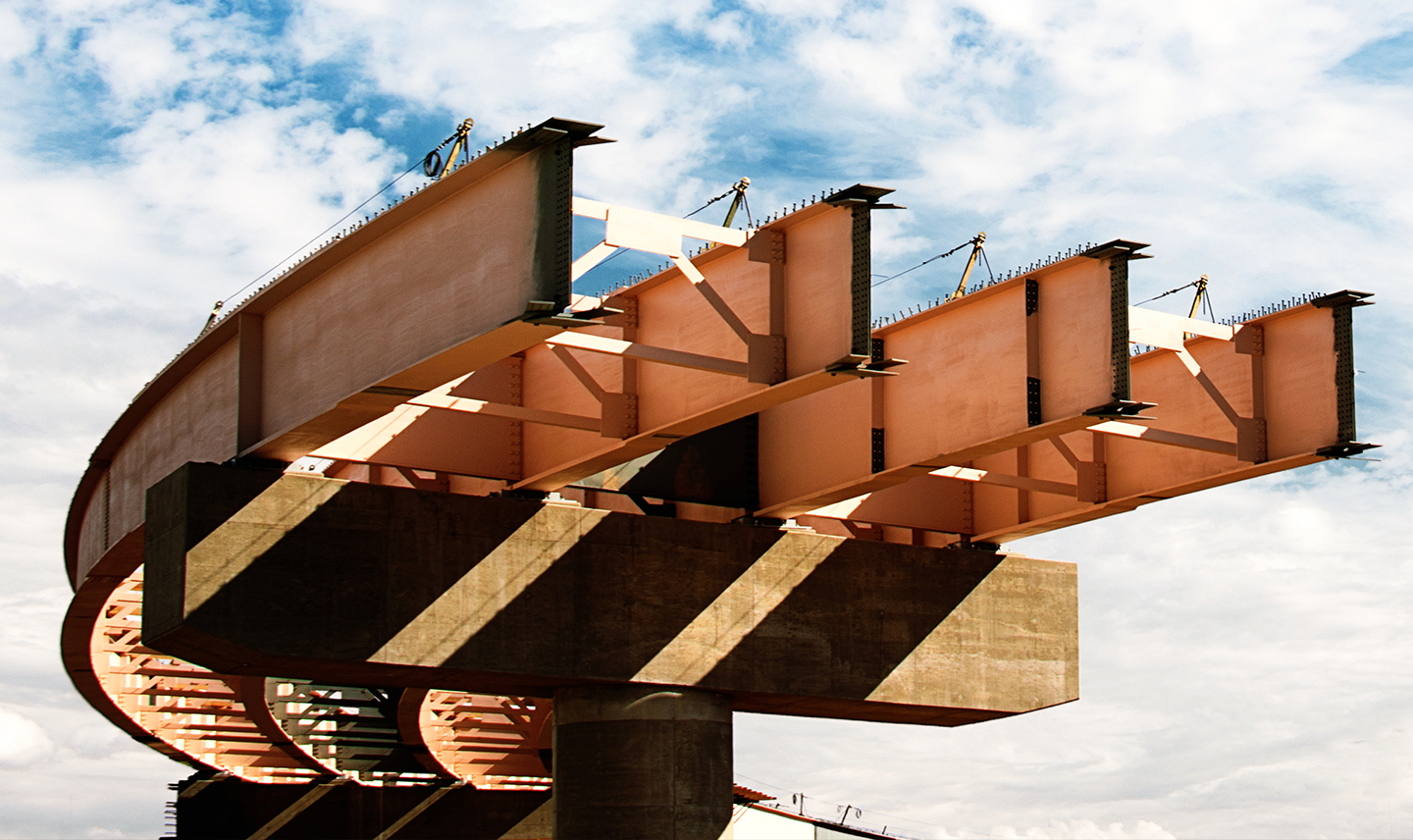Roads crack. Bridges crumble. Sewage leaks and power grids fail. America’s infrastructure is falling apart. Auburn alumni and faculty discuss the problems and solutions to a national crisis.
By Derek Herscovici ’14

John C. Morris ’82 stands in front of Thurlow Dam in Tallassee, Ala.
Infrastructure—the roads, the power grids, the water lines, the shipping ports—is foundational to civilization, enabling populations to thrive and commerce to flourish.
Future president Dwight D. Eisenhower recognized it as early as 1919 when he participated in the first military convoy across America. The journey from Washington, D.C. to San Francisco was fraught with incomplete roads, impassable bridges and dangerous terrain. In three days, Eisenhower calculated they had spent 29 hours on the road and moved 165 miles.
Those experiences contrasted sharply with what he encountered while leading the Allied forces in Germany during WWII. Seeing the effectiveness of the German autobahn, Eisenhower as president resolved to bring it to America.
“When we finally secured the necessary congressional approval, we started the 41,000 miles of super highways that are already proving their worth,” wrote Eisenhower in his memoir “At Ease.”
For decades, American infrastructure improved and evolved. But today it’s in trouble. Every four years, the American Society of Civil Engineers (ASCE) grades the status of and condition of different infrastructure elements. Its 2021 report card gave the U.S. a C-, an improvement over 2017’s D+ rating but a reflection of the looming crisis that has been incrementally building.
In 2022 the federal government helped pass the Inflation Reduction Act, which committed billions of dollars to infrastructure projects around the county—one of the most significant investments in American history. But will it be enough?
Infrastructure Repair Isn’t Sexy
“Something new in your district is high-profile, it’s important and it brings in a whole bunch of new dollars. That’s a whole lot more attractive as an option [to politicians] than bringing in repair dollars,” said John C. Morris ’82, a political science professor and an expert on federal infrastructure funding. “If they have to cut something, you cut the thing that people are less likely to notice. A lot of times that tends to be things like maintenance on existing infrastructure.”
At the time of our conversation, Morris was headed to Capitol Hill, where he and a coalition of interest groups, the EPA, governmental agencies and colleagues from around the country were to advise Congress on the future of wastewater management in America. Funding from the $1.7 trillion Inflation Reduction Act will help improve current wastewater facilities, but the funding process itself is a much more entrenched issue.
Roughly a billion dollars every year is divided among states and territories as grant funding for infrastructure projects. The system gives states greater autonomy over their own projects, but the limited funding must be loaned out and repaid by localities to the federal government. This short-term solution was intended to expire by 1994 but has been prolonged to the breaking point.
Particularly since the anti-tax movement that began in the 1980s, state governments are under additional pressure to keep tax rates low. In terms of real dollars, that means that states are working with smaller budgets, and the only communities that receive assistance are often the kind that can afford to pay back loans with interest.
Morris points to cities like Jackson, Miss., which experienced a shortage of drinking water in 2022 after an outdated facility failed. An impoverished community with a smaller system, Jackson residents face costs comparable to bigger cities to fix it.
“The resources tend to go to the bigger, wealthier communities because they’re more able to afford that,” said Morris. “[Poorer communities] don’t invest, because they can’t.”
“If they have to cut something, you cut the thing that people are less likely to notice. A lot of times that tends to be things like maintenance on existing infrastructure.”
Auburn’s Advanced Structural Engineering Laboratory is one of the largest structual engineering labs in the world and features a high bay laboratory with a strong wall and strong floor to handle extreme structual testing loads.
Auburn Goes to Work on Infrastructure
Alumni and faculty members across dozens of fields and disciplines are already working on projects directly related to improving the nation’s roads, bridges, water systems and power grids.
David Roueche, an associate professor of structural engineering specializing in hurricanes and tornadoes, is studying the effects of extreme winds on buildings and how to design structures that can provide better protection.
Anton K. Schindler, a civil and environmental engineering professor and director of Auburn’s Highway Research Center, is working on types of concrete that are “self-consolidating” and lead to accelerated repair, improved durability and significant cost savings.
The National Center for Asphalt Technology (NCAT), a research center with a 1.7-mile test track not far from Auburn’s campus, has become an indispensable asset for pavement engineers working in highways and roads.
Opened in 2000 as a testing facility for asphalt research, the track has provided pavement engineers across the country with an outdoor laboratory where they can experiment with pavement designs while avoiding risks associated with real-world roadways. The NCAT test track offers researchers a unique chance to design, implement and show their findings on asphalt technology in one location. It has saved state departments millions of dollars each year with its results.
For Eric Dunlap ’06, a civil engineer for Los Angeles County, taking on the infrastructure challenge can make for a better drive and save lives. As an advocate for the Vision Zero initiative, an international movement to end road deaths and injuries, Dunlap is helping create roadways, vehicles and traffic systems that factor in road safety as well as human error.
“In Los Angeles County, we average 730 fatal crashes each year, with 15 percent occurring in the county’s unincorporated communities. Canada and Australia, whose road networks and mode shares are very similar to ours, have fatal crash rates half that of the United States,” said Dunlap. “One significant reason is that we’ve designed our roadways with wide travel lanes and large radii that promote high vehicle speeds and efficiency over safety. The faster a vehicle travels, the more likely a crash will be deadly because of the increased kinetic energy.”
Dunlap recently reconfigured a four-lane roadway, one of L.A.’s most dangerous, into a two-lane one with room for bicycles and pedestrian amenities, ideal for a neighborhood where one in seven residents rely on walking, biking or transit.
“The Federal Highway Administration proves these reconfigurations reduce the chances of a collision by nearly 50 percent, and it’s our responsibility to do everything we can to ensure people can reach their destination safely.”
“On a national scale, it’s a big difference. So we are making progress. But not as fast as many people would like.”
Building Codes for Future Bridges
While the Inflation Reduction Act will undoubtedly make an impact, the reality is it’s hardly a drop in the bucket. The true cost of America’s infrastructure woes are so much greater they defy comprehension. With no feasible way to fix everything at once, hard choices have to be made.
“This is very difficult to admit, but society accepts a certain level of risk—and accepts that a percentage of structures will be destroyed—because society doesn’t have enough money to fix everything,” said professor Andrzej Nowak, department chair of Civil and Environmental Engineering and the Huff Eminent Scholar Chair for Structural Engineering.
“Politicians are very cautious when they talk about this. These funds are not millions, these are billions of dollars. We are talking about big, big money, and one of the things that is needed is, how do we plan to use that money? This is where Auburn University is working.”
Calculating the appropriate aversion to risk is a critical part of Nowak’s research in structural engineering, particularly related to bridges. Of the estimated more than 600,000 bridges in the U.S., nearly 10% are in such bad condition they should not be used.
To assess which are in danger, Nowak and his doctoral students calculate how many crossing trucks a bridge can handle per year, computing it with the average age of failing bridges in the U.S.—about 75 years.
Working in collaboration with the Alabama Department of Transportation their goal is “target reliability,” where safety is at an acceptable, cost-effective level that can be replicated around the world. It’s a tedious process, but one that’s already showing signs of progress.
“About 20 years ago, the statistics showed that about 15 percent of bridges should not be used. Today it’s less than 10 percent,” said Nowak. “On a global scale, on a national scale, it’s a big difference. So we are making progress. But not as fast as many people would like. If there was an easy answer to this question, it would already be answered.”
Auburn Alumni are at work improving every aspect of American infrastructure. Read a few of their contributions below.
Are you working to improve American infrastructure?
Q&A with Trammell Starks Recording Engineer, Lucky Man Studio
Renowned recording engineer and former touring keyboardist Trammell Starks shares how Lucky Man Studio is shaping Auburn into a top-tier destination for music production and education.
Rebuilding the Dream
The School of Architecture, Planning and Landscape Architecture is changing the way the world is built, one project at a time.
Power Charged
With energy costs rising and grids failing, Auburn is developing new energy sources to power the future.




